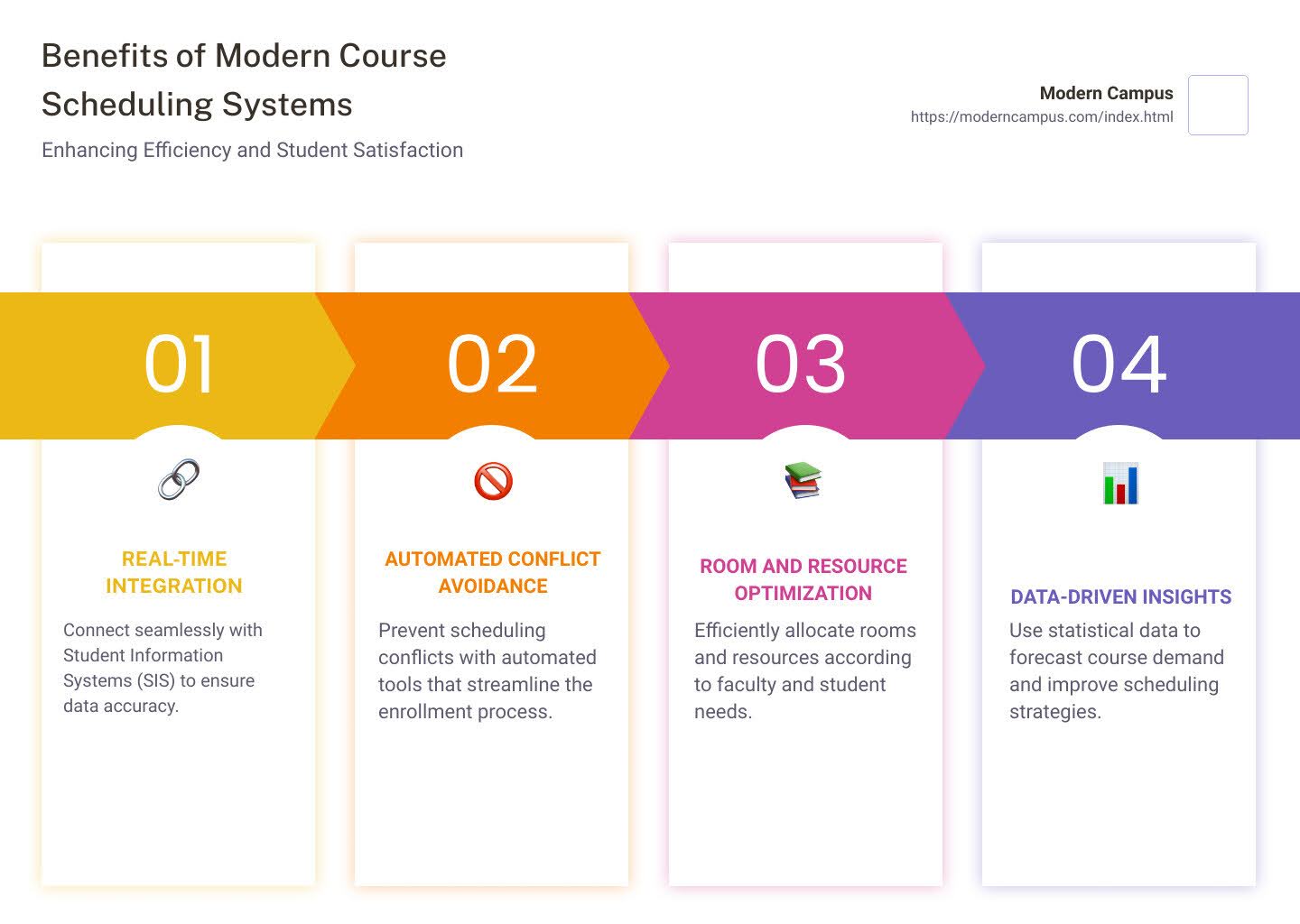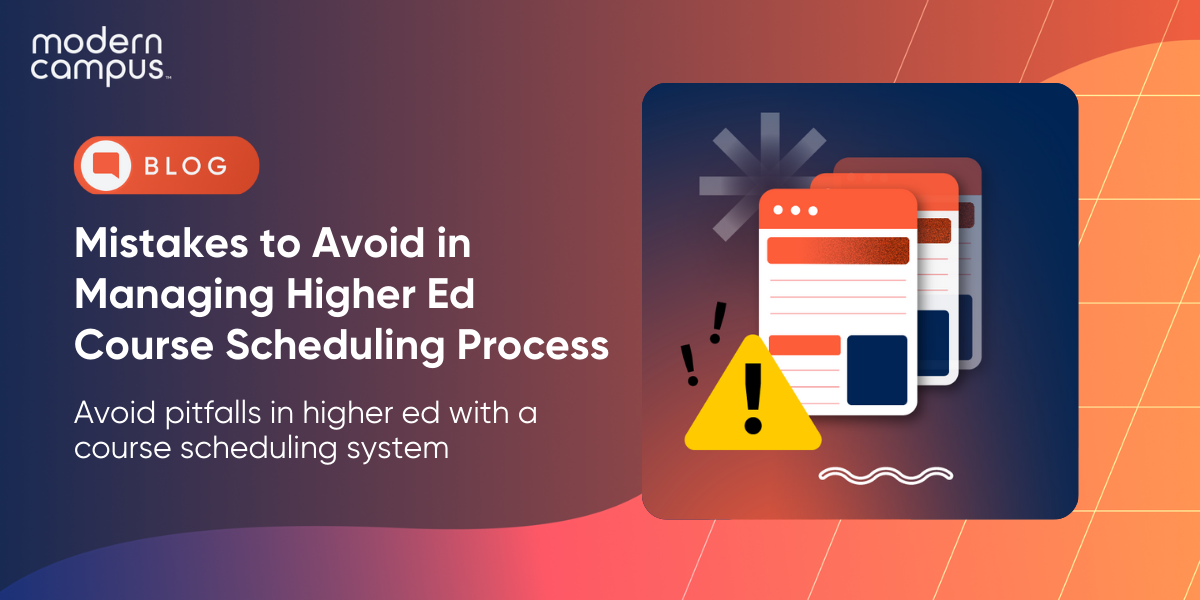Mistakes to Avoid in Managing Higher Ed Course Scheduling Process
Efficient course scheduling is at the heart of a well-functioning higher education institution. It directly impacts student success, faculty satisfaction and the optimal use of campus resources. Yet, the process is often riddled with challenges—from balancing student demand with faculty availability to avoiding room conflicts and ensuring equitable access to courses. Without the right tools and strategies, even minor scheduling issues can snowball into major headaches for administrators and students alike.
Modern course scheduling platforms offer a way to overcome these challenges by streamlining the process.With this, they’re able to provide actionable insights and foster collaboration across departments. By integrating automation and data-driven decision-making, institutions can navigate the complexities of scheduling with ease to ensure a more seamless experience for everyone involved.

Overlooking Student Needs in Schedule Planning
In the quest to optimize course scheduling, it's easy to forget the core purpose: serving the students. A well-designed course scheduling system can make the difference between a frustrating registration experience and a smooth academic journey.
Ignoring Flexible Learning Options
Today's students demand more than just traditional classroom settings. They crave flexible learning options that accommodate their diverse needs. Unfortunately, many institutions still overlook this trend, sticking to rigid and outdated schedules.
Course diversity is key. A robust scheduling system should incorporate online, hybrid and in-person courses that allow students to have choices that fit their lifestyles. At the same time, this flexibility boosts student engagement and increases retention.

Neglecting Equitable Access to High-Demand Courses
High-demand courses often create a bottleneck in the scheduling process. Students find themselves stuck on waitlists, unable to enroll in essential classes needed for graduation. This is a common pain point that can derail academic progress.
To tackle this, institutions must prioritize equitable access. By analyzing enrollment trends, a scheduling system can predict which courses will be overfilled and proactively adjust capacity or sections. Implementing a data-driven approach ensures that all students have a fair shot at enrolling in the courses they need.
By focusing on student needs and leveraging modern scheduling solutions, universities can create a more inclusive and efficient academic environment. Institutions are able to enhance students’ experiences while elevating their reputation for fostering a supportive and engaging educational environment.
Relying on Outdated Tools and Manual Processes
In higher education, relying on outdated tools like spreadsheets for scheduling can lead to a host of problems. Spreadsheet-driven scheduling might seem simple, but it's a manual process that often results in errors and delays.
How Manual Workflows Lead to Errors and Delays
Manual workflows in course scheduling are prone to mistakes. When you're dealing with hundreds or even thousands of courses—small errors can snowball into big issues.
Scheduling errors are common when using spreadsheets. Overlapping class times, incorrect room assignments and mismatched faculty schedules are all possible. These errors lead to bottlenecks, causing frustration for students and faculty alike.
Manual processes are also time-consuming. Institutions can save significant time on scheduling by switching to automated systems.
The Benefits of Automation in Scheduling
Automation is the key to overcoming these challenges. By using advanced scheduling software, institutions can streamline the entire process.
Automated systems reduce errors by syncing data in real time and providing built-in alerts for potential conflicts. Technology ensures that schedules are accurate and up-to-date. For example, some platforms have shown a significant reduction in scheduling bottlenecks, making the process smoother for everyone involved.
Additionally, automation allows for dynamic rule-building. Course sections can easily be adjusted based on faculty preferences and institutional policies. The result is a more efficient and flexible scheduling system that adapts to changing needs.
By moving away from manual workflows and embracing automation, universities can create a more efficient and error-free scheduling process.
Poor Collaboration Between Departments
Effective course scheduling is also about ensuring that all departments work together seamlessly. Scheduling conflicts often arise when departments operate in silos, leading to overlapping classes and resource allocation issues. To avoid these pitfalls, universities must prioritize centralized communication and cross-departmental coordination.
The Importance of Centralized Communication
Centralized communication is crucial for preventing scheduling conflicts. When departments communicate through a unified platform, they can share vital information about course offerings, faculty availability and room allocations. Transparency helps to align departmental needs and schedules, reducing the risk of conflicts.
Using communication tools allows for real-time updates and notifications, ensuring that everyone stays informed. For instance, when a course schedule is adjusted, all relevant departments can be notified instantly, preventing last-minute surprises.
Facilitating Cross-Departmental Coordination
Cross-departmental coordination is key to a smooth scheduling process. By fostering collaboration between departments, universities can align their policies and scheduling practices. All parties can work towards the same goals—like maximizing classroom space and meeting student demand.
This is where policy alignment plays a vital role. When departments agree on scheduling policies and priorities, they can avoid conflicts and work more efficiently. Modern platforms offer features that enable departments to seamlessly integrate their scheduling requirements with institutional policies.
Moreover, facilitating collaboration can lead to innovative solutions. Departments can share insights and strategies, improving the overall scheduling process. For example, a shared understanding of course demand projections can help departments adjust their offerings to better meet student needs.
At the end of the day, prioritizing unified communication and interdepartmental collaboration allows universities to reduce scheduling conflicts and foster a more cohesive academic experience.
Ignoring Data-Driven Decision Making
Relying on gut feelings or outdated methods for course scheduling is a recipe for chaos. Data-driven decision-making is the key to creating efficient and effective schedules that meet the needs of both students and faculty.
Leveraging Predictive Analytics for Better Planning
Predictive analytics is like having a crystal ball for course scheduling. By analyzing historical data, institutions can forecast future course demand and make informed decisions. Adopting this approach helps universities anticipate which courses will be popular and ensure they have enough sections to meet demand.
For example, if data shows that a particular course has been overfilled for the past three semesters, predictive analytics can suggest increasing its capacity or offering additional sections. Staff can prevent bottlenecks and ensure that students can enroll in the classes they need.
Using advanced scheduling platforms helps universities access these insights. By integrating predictive analytics into their course scheduling system, institutions can optimize their offerings and improve student satisfaction.
Using Real-Time Data to Adjust and Optimize
While predictive analytics helps with planning, real-time data is essential for making adjustments on the fly. Course demand can fluctuate, so universities need to adapt quickly. Real-time data allows higher education institutions to monitor enrollment trends and make necessary changes to the schedule.
For instance, if a course is filling up faster than anticipated, the scheduling team can add more seats or open a new section to accommodate students. On the flip side, if a course is under-enrolled, resources can be reallocated to more in-demand classes.
Modern scheduling platforms provide real-time updates and alerts. Schedulers can make informed decisions quickly, reducing the likelihood of overfilled or underfilled sections. With features like schedule optimization, universities are able to enhance the academic experience by maintaining a balance between course offerings and student needs.They’re also able to transform their scheduling process by embracing data-driven insights and leveraging both predictive analytics and real-time data. When students have access to their required courses, staff are able to streamline operations and support student success.
Avoid the Chaos and Streamline Your Course Scheduling Process
Leveraging technology in scheduling is necessary for today's universities to succeed. Institutions that rely on outdated methods like spreadsheets and manual processes often face errors, delays and student dissatisfaction. These challenges can be significantly reduced by transitioning to a modern course scheduling system.Modern platforms streamline the scheduling process, providing a seamless experience for both students and staff. With digital tools, institutions can automate schedules to ensure accuracy and efficiency. Technology helps save time and improves the overall academic experience by preventing scheduling conflicts and optimizing course offerings.
Modern Campus offers a platform that integrates real-time data and predictive analytics to help institutions make informed decisions. By analyzing enrollment trends and course demand, our platform ensures that resources are allocated efficiently, improving access to high-demand courses and supporting flexible learning options.
Modern Campus excels at guiding you through the learner-to-earner lifecycle, ensuring your institution remains a pillar in the community while adapting to the evolving needs of modern students. Request a demo today to see how Modern Campus can help your institution improve student engagement and streamline operations.
Last updated: February 4, 2025

